Circuit 1 Schematic, Photo, and Demonstration
The circuit’s purpose was to have a fading light come from an LED. This involved using the Arduino, an LED, and a 10k ohm resistor. To make this circuit work productively, we used the “Fading” example for code and then had a power source connected to D9 input. From there we used a breadboard and had the power cable going from the Arduino to a 10k ohm resistor and then running through an LED lights before returning to ground in the Arduino. Once we uploaded the code to our arduino, the fading of the LED worked perfectly and we has no issues. This made us both eager to tackle the next circuit and see if we can use other Arduino programs with lights successfully.
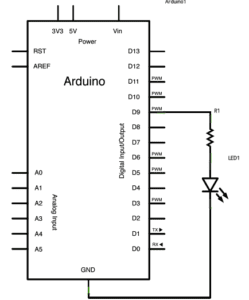
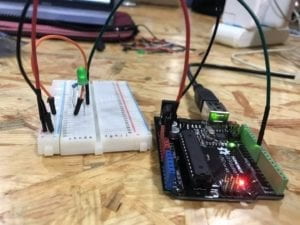
Circuit 2 Schematic, Photo, and Demonstration
This next circuit’s purpose was to play a melody through a buzzer/ speaker. Our power source came from input D8 on the Arduino and ran into a buzzer/ speaker. From there, the circuit was connected back to ground on the Arduino. To run our code we went to the toneMelody example in the digital section and uploaded it to our Arduino. From there we were able to hear the melody being played and were lucky that we ran did not run into any issues with this circuit as well.
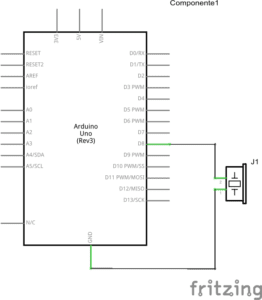
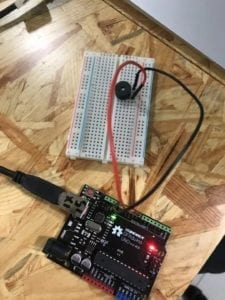
Circuit 3 Schematic, Photo, and Demonstration
In the 3rd and final circuit, we were tasked with creating a game in which two people could see who could tap a button faster within a given number of taps. If completed correctly, the Arduino program was to let us know when to begin and whoever was the winner had an LED light that was to light up if they won.To begin the circuit, we had a 5 volt input as our power source. We also had one input each from D10 and D11 that each connected to its own set of one switch and 220 ohm resistor before going to ground. We also had two inputs from D3~ and D2 that each ran through its own set of one LED light and a 10k ohm resistor before running back to ground as well. The D8 input had a wire that ran from the input to the speaker and from the speaker back to ground. We also had a code that was given to us on the projector that we were to copy and paste into a new Arduino file. With this uploaded, we were able to go to the serial monitor, where words that appeared on the screen would count us down to mashing the buttons. Initially, we forgot to look at the serial monitor when testing our circuit so we looked through each connection an extra time to made sure we were building it correctly. Once we figured this out, we began running the code and the entire circuit and game worked perfectly. We realized that we should always run our code first to see if it works before taking apart the circuit again.
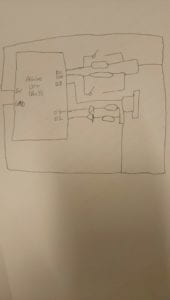
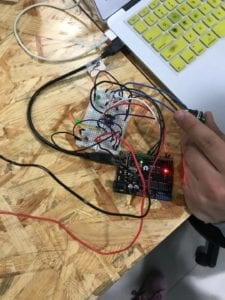
The text “Physical Computing” really put into context for me how I interact with technology on a daily basis. I can now look at things, such as scanning my identification card while I’m entering school and know that those machines are in a digital space. The reading also narrowed down my view of what a computer and computing is, mostly because beforehand I also had the idea that computers looked like a screen, keyboard, and mouse. Now that I know that different methods of transduction and how things are more complicated than simply digital/ analog, input/ output I can see that the order in which things are processed, whether they are parallel or serial matter as well. One thing I found fascinating and that I will definitely keep in mind while I am creating projects in this class is the advice that was given when it came to brainstorming ideas. Despite all the complexities behind programming and making circuits and/ or microcomputers, it is important to look at you idea through its very basic connection and to not overanalyze or try to perfect what you have at first. This is something I have always been prone to do, especially being a social science major and writing tons of papers. I realize that I have to start basic and work my way up. Higher levels of abstraction can actually be a distraction when you begin working on a project because you do not want your ideas to become convoluted. I define interaction as communication between objects, whether they be living or not. I think that many of the parts of a circuit are interactions, just like I think moving an analog stick is an interaction. Circuits and computers are created by a team of things and when one thing goes wrong or has trouble, the entire thing is in jeopardy.
Question 2:
To be honest, I can assume all I want that 100,000 LEDs could lead to a very bright, visible light, but depending on how high in the sky I want them and the weather, they could be difficult to see. Initially, I thought of how practical this light would be at an airport or a shoreline to prevent crashes, but personally I would want to put all of the lights in the sky where they could light up different positive messages to the people below. I would want to put them on some sort of balloon or another device in the air and have they blink in different languages. Then again, I would know exactly what is powering them so I feel like that would inhibit my power sources for this project. If need be, I could make this project stationary as well as place it somewhere where people are in need and try to cheer them up with some sort of light show.